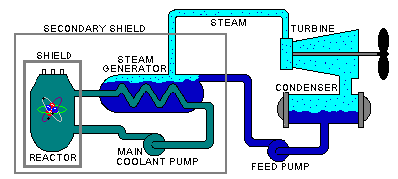The basic elements of a fission reactor are:
reactor core for holding fission material or fuel
moderator for slowing fast neutrons
control rods holding neutron absorbers to control rate of fission
monitoring system containing devices and indicators of operation
energy transfer system to take the heat away
How The Reactor Works

The nuclear reactor above uses a pressurized water reactor design which has two basic systems - a primary system and a secondary system. The primary system circulates ordinary water and consists of the reactor, piping loops, pumps and steam generators. The heat produced in the reactor is transferred to the water under high pressure so it does not boil. This water is pumped through the steam generators and back into the reactor for re-heating.
In the steam generators, the heat from the water in the primary system is transferred to the secondary system to create steam. The secondary system is isolated from the primary system so that the water in the two systems does not intermix.
In the secondary system, the steam flows from the steam generators to drive the turbine generators, which produce electricity. After passing through the turbines, the steam is condensed into water which is fed back to the steam generators by the feed pumps. Thus, both the primary and secondary systems are closed systems where water is recirculated and renewed.
Moderators are compounds containing light nuclides such as H, D, He, C, O, F. Materials with low neutron-capture cross section are desirable. The following substances are commonly used as moderators.
graphite,
![]()
![]() (100 Atm and 1273 K)
(100 Atm and 1273 K)
![]() (hightemperature liquid metal).
(hightemperature liquid metal).
![]() (773to 873 K used in breeder reactor)
(773to 873 K used in breeder reactor)
![]() (forGCR)
(forGCR)
Materials with high thermal-electron-capture cross section are desirable - these have a high probability of capturing the electrons. Usually, cadmium, boron, carbon, cobalt, silver, hafnium, and gadolinium are common elements used in control rods.
Reactor Types
After the war, the United States set up a Civilian Power Reactor Program (CPRP) to coordinate the study of nuclear reactors for peaceful application of nuclear energy. The Atomic Energy of Canada, Limited was and still is the Canadian body for nuclear technology applications.
It's purpose was to find out the most economical and safe way to produce energy from nuclear fission. The first few nuclear reactors were built to study how nuclear reactors function, and perhaps to produce plutonium for atomic bombs. to electric energy. The Program decided to investigate the following eight types of power reactors:
Fast Breeder Reactors (FBR)
Aqueous Homogeneous Reactors (AHR)
Heavy Water Moderated Reactors (HWR) (the CANadian DeuteriumUranium (CANDU) reactor)
Pressurized Water Reactors (PWR)
Boiling Water Reactors (BWR)
Organic-Cooled Power Reactors (OCPR)
Sodium Graphite Reactors (SGR)
Gas-Cooled Reactors (GCR)
